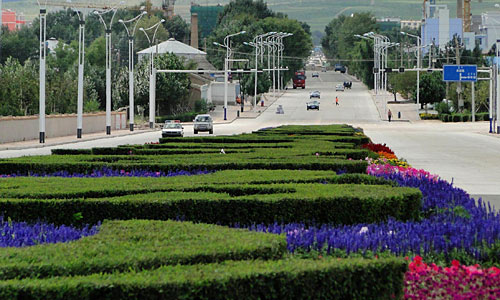|
 |
|
A GREEN TOWN: A street at the seat of Tuquan County, Hinggan League of Inner Mongolia Autonomous Region. In recent years, the town has invested a large amount of money in improving its environment. Green space accounts for more than 37 percent of its total urban area (LI XIN) |
Aotegen Chagan, a former herdsman of the Gandeer Grassland in Ejin Horo Banner, south Inner Mongolia Autonomous Region, runs four Mongolian yurts on the pasture near the Genghis Khan Mausoleum to attract tourists.
The 56-year-old says, because of overgrazing and the pressure of rapid population growth, desertification became worse on the Gandeer Grassland during the 1980s.
"From then on, we herders started realizing that we could not lead our life like before. It was time for us to let the grassland have a rest and find new lives in other places," he said.
In order to regain the ecology of Inner Mongolia, with the support of the Central Government, Inner Mongolia has taken a series of measures to protect its natural grassland and forest resources, such as converting farmland into forest, returning grazing land to grassland and encouraging ecological migration.
With all issues being tackled, grassland and forest ecology have greatly improved in recent years, said Ah Long, Deputy Director of the Publicity Department of the Inner Mongolia Autonomous Regional Committee of the Communist Party of China, at a recent press conference in Hohhot, capital of the autonomous region.
Data from the regional agriculture and forestry departments show, Inner Mongolia at present has 88 million hectares of natural grasslands and 23.67 million hectares of forest.
But Ah Long also admitted part of the ecology was still there and it would require time and patience to change the situation.
Great measures
In 2000-09, the Central Government invested 42.9 billion yuan ($6.28 billion) and accomplished 7.93 million hectares of forestry construction in Inner Mongolia, according to Li Shuping, Director of the regional forestry department.
By the end of 2009, the forest coverage rate increased to 20 percent from 14.8 percent in 2000, Li said.
In 1989, a grassland contract system was introduced and then the grasslands gradually became family ranches in Inner Mongolia.
The latest survey conducted by the regional agriculture and animal husbandry department shows 66 percent of the total natural grasslands in Inner Mongolia have become family ranches.
"The land contract system has turned herdsmen into ranchers, making them more responsible for protecting the prairie environment," said Tuya, a researcher with the Pasture Economy Research Institute of the Inner Mongolia Academy of Social Sciences.
By the end of 2009, the Central Government had put more than 5.2 billion yuan ($761 million) and returned 12.69 million hectares of grazing lands to grasslands.Along with converting grazing land to grassland, the ecological relocation program was put on the agenda.
Since the end of 1999, the region has invested more than 2 billion yuan ($292 million) in ecological relocation, in which 450,000 people, including 100,000 herders, have been relocated, says the region's agriculture and animal husbandry department.
| 